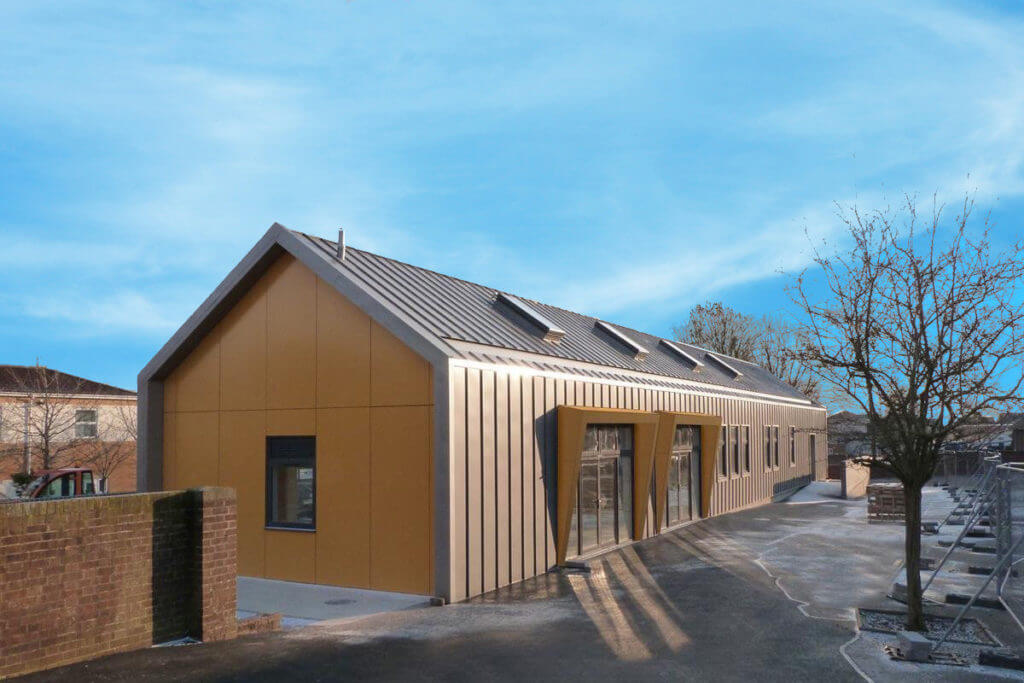Filton Avenue Primary School: SIP Cladding Project
About the project
ARCHITECT: Studio Lime
PROJECT TYPE: Educational - SIP Cladding
System Products:
142mm SIP Panel
The panels are typically 1220mm wide and can be as long as 7.5 metres in length to suit each individual project. https://sipbuilduk.co.uk/sip-walls/
172mm SIP Panel
The panels are typically 1220mm wide and can be as long as 7.5 metres in length to suit each individual project. https://sipbuilduk.co.uk/sip-walls/
Block Floor
A block floor is a term used to describe a floor system called a “beam and block floor.” This method of constructing domestic floors is widely used and involves the use of precast concrete beams and blocks. https://sipbuilduk.co.uk/sip-flooring/
VCL / Nilvent
VCL stands for Vapour Control Layer: Nilvent, on the other hand, refers to a specific brand of breathable wall and roofing underlay. It is a type of roofing membrane that allows moisture vapour to escape from the roof while providing protection against the elements.
Educational Structure – tbc + *2017
The costs provided are totally indicative and should be used informatively and not part of any detailed budgeting process. How long is a piece of string comes to mind!!! https://sipbuilduk.co.uk/sip-cost/
We do hope however that this helps to provide a picture of what can be achieved with our structures within different budget ranges.
Filton Avenue Primary School
Filton Avenue Primary School students benefit from offsite construction for their new dining hall, built in weeks using SIPs (Structural Insulated Panels) wrapped around a steel structural frame.
Due to recent increases in student enrolment, the school needed to upgrade its lunch facilities. The architect Studio Lime proposed a simple pitched roof design with bright cladding to encourage students to eat healthy meals in the school.
The project involved the construction of a new, stand-alone dining hall to serve a city-centre primary school in North Bristol. It replaced a 1950s timber framed annex that had come to the end of its life and was proving too small for the number of pupils at the school.
The building includes a large central hall, a commercial kitchen and an external dining terrace. The hall is dividable and has an adjacent kitchenette and WC, allowing most of the hall to be emptied and made available for community uses.
In order to avoid encroaching onto the adjacent playground and playing fields (neither of which would have been welcomed to the Local Authority), the new building matches the width of the previous dining hall.
The length of the proposed development area has been increased into a disused part of the school grounds to provide the extra space necessary to serve current pupil numbers. This resulted in a long, thin, building that rises out of the ground on a plinth as the topography falls away.
Construction was completed during term time. To minimise disruption (Main Contractor was Jones Building Group). The use of offsite manufacturing meant that the panels were made offsite, site waste was minimised, and the panels could be quickly erected. In addition, once a breather membrane was applied to the outer face of the panels, the structure was weathertight, allowing internal trades to begin work.
It was also essential that the building achieve high energy efficiency. The SIPs supported a fabric-first construction approach, limiting the heating demand of the building. The insulated core of the structural insulated panel allowed U-values of 0.17 W/m2K to be reached on the wall and roof whilst its OSB/3 facing and unique jointing system minimised air leakage through the building envelope.
Under the Bristol Core Strategy, it was also essential that the building achieved a high level of energy efficiency. The SIP panels supported a fabric-first construction approach, limiting the heating demand of the building. The insulated core of the structural insulated panel, allowed U-values of 0.17 W/m2.K to be reached on the wall and roof whilst its OSB/3 facing and jointing system minimised air-leakage through the building envelope.
The lightweight design and excellent spanning capability of the panels also allowed the size and weight of the roof support to be significantly reduced compared with alternative fabric options.
A fantastic new asset for the school and the pupils.

Image credits | Studio Lime and SIP Build UK
“The SIP System was chosen to reduce the on-site duration of the project and the noise and disruption that goes with it. A number of classrooms are located nearby and operated effectively for the duration of the project. We were also keen to use the system as it allowed us to get a weatherproof envelope as quickly as possible, reducing the scope for delays.” “By using the SIPs panels on the roof and walls, we were able to have consistent detailing across the whole of the building envelope,” Alex continued. “This significantly reduced the number and complexity of different interfaces, minimising the potential for future maintenance issues.”
Alex Robertson - Architect


